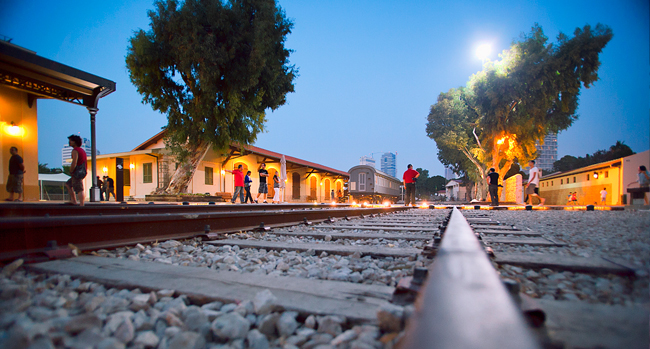Two of my favorite places in Israel are train stations, the first train stations in Tel-Aviv and Jerusalem.
 |
| Old picture of Train Station in Jerusalem |
Today train service is no longer available at these stations, and both train stations are shopping centers.
 |
| Old Train Station Jaffa |
But both train stations, especially the depot in Jerusalem are cultural centers as well as train stations.
 |
| First Train Station, Jerusalem |
My family and I have attended a film festival, a book fair and and several concerts in
the First Train Station.
 |
| Beit Shemesh train station looking east |
Railroad service was first proposed for the land of Israel by Moses Montefiore in the 1830’s. At that time travel within the land of Israel was by foot or by camels. The trip to Jerusalem was long and hard.
 |
| Bet Shemesh Train Station looking North |
The route a ride from the port city of Jaffa crossed the Plain of Sharon from the port of Yafo to Lod (or Lydda).
 |
| Beit Shemesh city sign |
Then the road entered the Sorek Valley, ascending to Beit Shemesh.
 |
| Zorah is on this Mountain |
This is the land of Samson and Delilah.
 |
| Farmland approaching Beit Shemesh |
Beit Shemesh is listed as a city both in the territory of Dan and in the Judean Hill country.
 |
| Judean Hills - Zorah in background |
The train ascends the Judean hills along the sorek river.
 |
| Sorek River running through the Judean Hills |
The ride is very beautiful. There are some olive groves along the way,
 |
| Olive Groves along Railroad Line |
But not many houses, for this is rugged country.
 |
| Defensive Structure in Judean Hills |
I was advised many times not to take the train, because the ride from Jerusalem to Beit Shemesh on the train takes longer than a bus ride. (about an hour) To get from the train station in Beit Shemesh to the airport requires three or four train transfers.
 |
| Old Railroad leaving Jerusalem Highlands |
We were not taking the ride to meet a time schedule, only to see the beauty.
 |
| Beauty from train window |
The train was for the most part empty because of people’s attitudes. That was ok for us, as we could take pictures from both sides of the train through the windows.
 |
| Train from Jerusalem to Beit Shemesh |
Near the top of the hill the train stops at a terminal across the street from the Biblical Zoo.
 |
| Looking across tracks from Biblical Zoo in Jerusalem |
The final stop is near German Colony.
 |
| Looking at park behind Jerusalem Train Station |
We enjoyed the smooth and beautiful ride very much.
 |
| Map of Israel Train zones |
In the near future there will be a high speed train from Jerusalem to the airport. Don’t know, but possibly train service on the old line will come to an end at that time.



